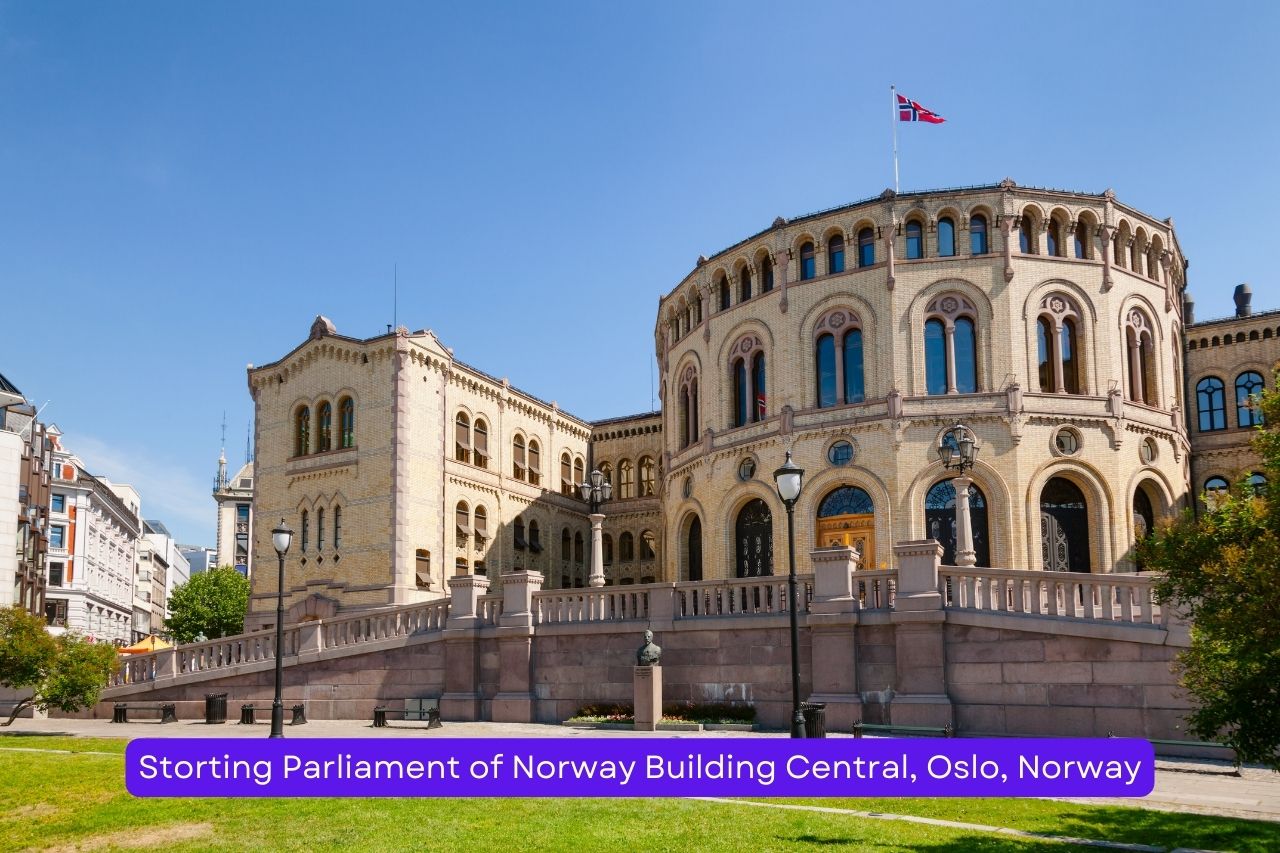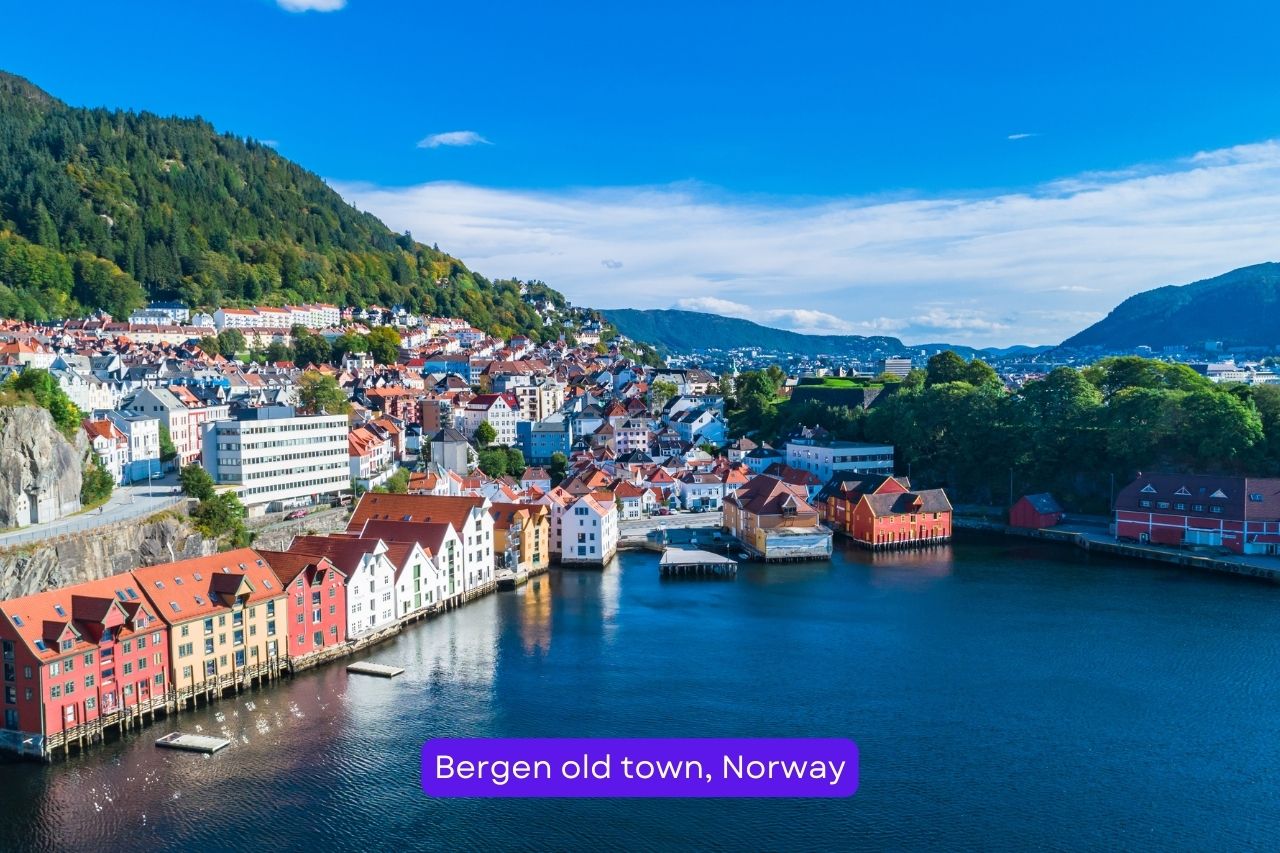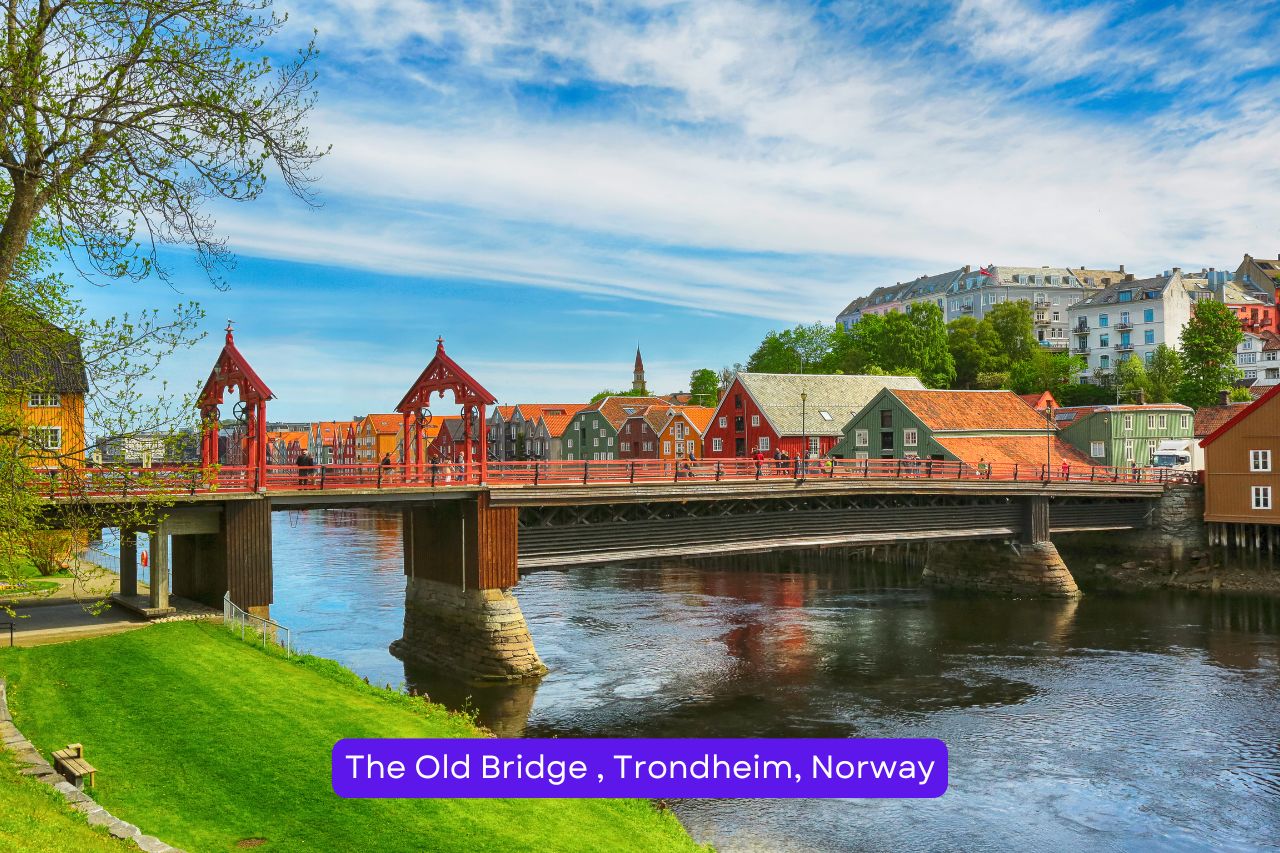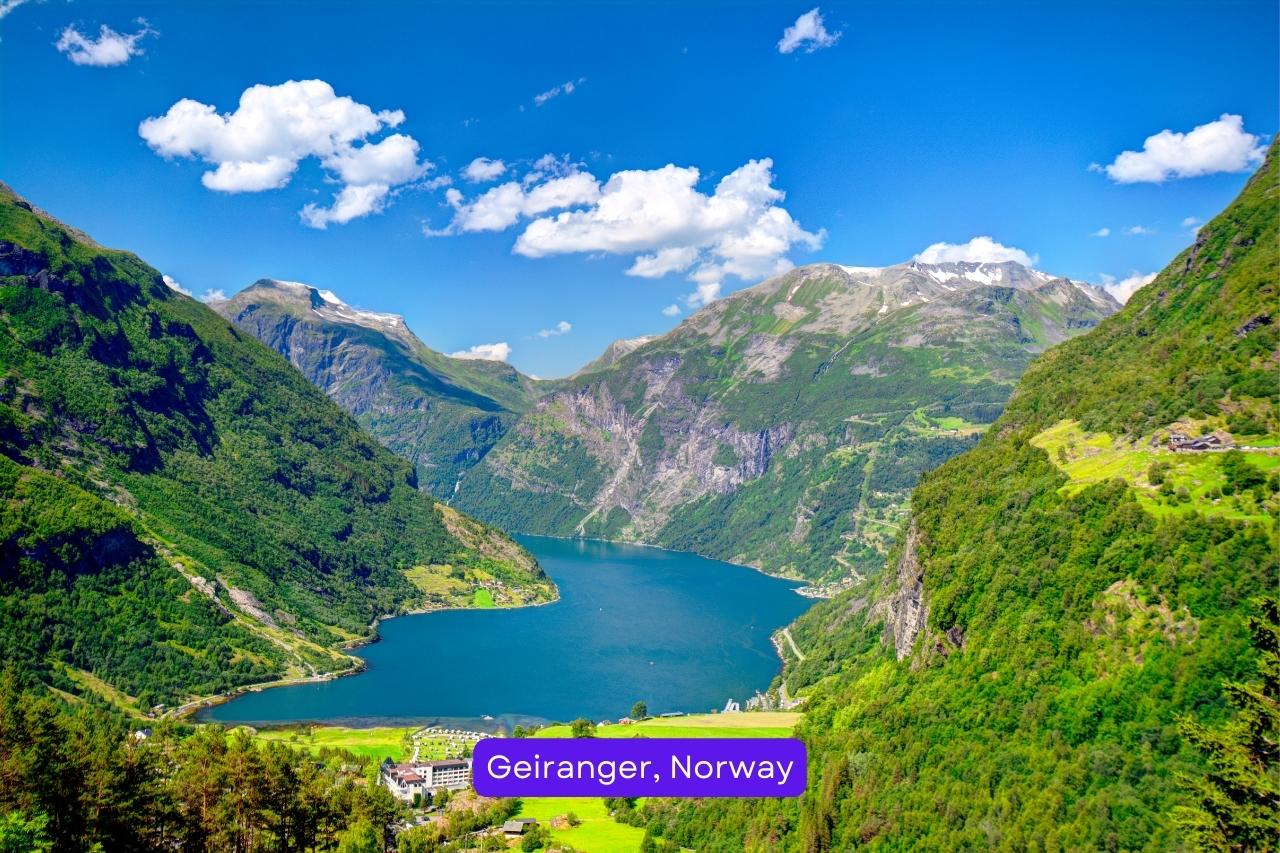Norway is a haven for outdoor enthusiasts with its breathtaking natural beauty. This hidden treasure in Scandinavia, with its breathtaking fjords, mystical Northern Lights, and rich historical tapestry, has a lot to offer travelers of all stripes. It provides a plethora of amazing experiences.
Oslo
Nestled between the Oslofjord and the surrounding wooded hills is Norway’s sophisticated capital. With easy access to both natural and cultural treasures like the visually stunning Oslo Opera House and the art-filled Munch Museum, Oslo is a chic, laid-back city. There are many activities available in Oslo, ranging from island hopping across the fjord to studying Viking-era relics at the Viking Ship Museum and admiring modern artworks at Ekebergparken. You may even indulge in an outdoor sauna to melt away the stress.

Akershus Fortress
- Address: Oslo, Norway
- Opening hours: 07:00 – 18:00
- Entrance fee: Free
Akershus Castle (Akershus Slott), often called Akershus Fortress (Akershus Festning), is a castle situated on the banks of Oslo Fjord that was constructed in 1299 as a home for the Norwegian royal family. Over the years, it has functioned as a Renaissance castle, a full-fledged 19th-century jail, and a fortification to defend Oslo against sieges by opposing Swedish forces.
Akershus Castle Church, the Royal Mausoleum, and several reception and banquet halls are among the attractions. Priceless items housed within the castle provide insight into Norway’s medieval and Renaissance past as well as the historic history of the building. The Norwegian Armed Forces Museum and the Norway Resistance Museum are located in Akershus Fortress, which also serves as the Ministry of Defense of Norway’s headquarters.
The Fram Museum
- Address: Bygdøynesveien 39, 0286 Oslo, Norway
- Opening hours: 10:00 – 17:00
- Entrance fee as follows
| Category | Fee (NOK) |
| Child/Student | 50 |
| Adult | 140 |
| Pensioner from 67 years old | 100 |
| Family max 02 adults + 05 child | 300 |
Anyone interested in Arctic exploration must visit the Fram Museum (Frammuseet), named after the first ship ever built in Norway especially for arctic study. The Fram, an iconic vessel recognized for her several successful arctic expeditions, and Gjøa, the inaugural ship to traverse the Northwest Passage, are the main draws of the museum. The engine room, crew quarters, and other parts of the Fram, which have been meticulously conserved and refurbished to authentically portray life on board, are open for exploration by guests.
The museum’s exhibits feature interesting artifacts including the ship doctor’s medical supplies and navigational devices, along with information on the journey. Other displays include subjects such as the achievements and life of the pioneers who cleared the path for Fram Captain Fridtjof Nansen.
Munch
- Address: Edvard Munchs Plass 1, 0194 Oslo, Norway
- Opening hours: 10:00 – 18:00 (Sunday – Tuesday) | 10:00 – 21:00 (Wednesday – Saturday)
- Entrance fee as follows
| Category | Fee (NOK) |
| Child under 18 years old | Free |
| Young 18-24 years old | 100 |
| Adult | 180 |
The Munch Museum, which houses the entire body of work of Norwegian symbolist painter Edward Munch, opened its doors in 1963 to coincide with the artist’s 100th birthday. His vast collection of letters is on display in the museum together with artwork and items he had given to the city, including a stunning array of paintings, prints, sketches, watercolors, sculptures, journals, photos, art supplies, and furniture. The Scream and Madonna, two of the most famous pieces in art history, are perhaps the most well-liked artworks here.
Viking Ship Museum
- Address: Huk Aveny 35, 0287 Oslo, Norway
- Opening hours: 10:00 – 16:00 (October – April) | 10:00 – 17:00 (May – October)
- Entrance fee as follows
| Date | Category | Fee (DKK) |
| 1 Jan – 30 Apr | Child under 18 years old | Free |
| Student | 80 | |
| Adult | 125 | |
| Family 02 adults + children under 18 years old | 230 | |
| 1 May – 20 Oct | Child under 18 years old | Free |
| Student | 105 | |
| Adult | 160 | |
| Family 02 adults + children under 18 years old | 300 | |
| 21 Oct – 31 Dec | Child under 18 years old | Free |
| Student | 80 | |
| Adult | 125 | |
| Family 02 adults + children under 18 years old | 230 |
The Viking Ship Museum (Vikingskipshuset), located on Oslo’s Bygdoy Peninsula, is home to a sizable collection of items from the Viking era that have been found in and around Oslo Fjord. The Viking ships housed in immaculate white halls have been meticulously restored and are the museum’s most famous feature. Look out for the three longboats from the Viking era, dating back to the ninth century, that were unearthed in Southern Norway after being buried for centuries in peat. See the well preserved Gokstad Viking Ship, which dates back to around AD 890, and the Oseberg boat, which is said to have been built specifically for the interment of affluent Vikings.
The Vigeland Park
- Address: Nobels gate 32, 0268 Oslo, Norway
- Opening hours: All day
- Entrance fee: Free
One of Norway’s most well-known tourist destinations is the recognizable Vigeland Sculpture Park (Vigelandsanlegget), which is located inside Oslo’s well-known Frogner Park (Frognerparken). With 650 of Gustav Vigeland’s dynamic sculptures in bronze, granite, and wrought iron, this one-of-a-kind sculpture park is open year-round.
Along an 853-meter-long axis, the sculptures are grouped into five themed groupings for the most part. The Fountain Group, which represents the life cycle of a human, is the oldest. It is situated beyond the 16-meter-tall Monolith, which is made up of 121 interwoven human bodies.
Oslo Opera House
- Address: Kirsten Flagstads Plass 1, 0150 Oslo, Norway
- Entrance fee: 100 DKK/adult & 60 DKK/Child 04-16 years old
The 1,364-seat Oslo Opera House (Operahuset), which is home to the National Opera Theatre and the Norwegian National Opera and Ballet, which is accentuated by its sloped outside surfaces. The Opera House, which is clad in white granite and Italian marble, is the biggest cultural structure to be built in Norway since the 14th-century Nidaros Cathedral in Trondheim. Aside from the numerous performances, guests may take part in a range of engaging public events, get behind-the-scenes, and wander around the building’s roof to take in the views.
The Royal Palace
- Address: Slottsplassen 1, 0010 Oslo, Norway
- Opening hours: 24 June – 17 August
- Entrance fee as follows
| Category | Fee (NOK) |
| Child under 06 years old | Free |
| Child 06-18 years old | 125 |
| Student/ Senior | 145 |
| Adult | 175 |
Built in 1825 and towering above the city, the Norwegian Royal Palace (Slottet) is situated high up on the northwest end of Karl Johansgate. During the summer, only, guided tours of the remarkable 173-room structure are given to the general public.
The White Parlour, Mirror Hall, Great Hall, Banquet Hall, Cabinet Parlour and Cloakroom, and other important rooms in the palace are all open for tours. All year long, visitors are also welcome to explore the gardens and grounds and take in the annual changing of the guard. The Norwegian Nobel Institute (Det Norske Nobelinstitutt), where the Nobel Peace Prize is given out, is located just south of the palace.
The Norwegian Museum of Cultural History
- Address: Museumsveien 10, 0287 Oslo, Norway
- Opening hours: 11:00 – 16:00 (except Monday)
- Entrance fee as follows
| Date | Category | Fee (NOK) |
| 1 May – 30 September/ Weekends/ Holidays | Child under 18 years old | Free |
| Student/ Senior from 67 years old | 140 | |
| Adult | 180 | |
| 1 October – 30 April (Tuesday – Friday) | Child under 18 years old | Free |
| Student/ Senior from 67 years old | 120 | |
| Adult | 140 |
The Norsk Folkemuseum, or Norwegian Museum of Cultural History, was established in 1894 and has been resurrecting Norway’s history from the Middle Ages to the present. The term “museum” is misleading since, despite some traditional elements, the “open-air” area retains 160 structures from each of Norway’s regions, making a stroll around the grounds feel like a trip through time.
The majority of tourists are compelled by the outdoor exhibitions, despite the inside exhibits’ allure. The outdoor museum depicts life in Norway from 1500 to the present, with displays ranging from rural homes and Old Town Christiania to the approximately 1200-year-old Gol Stave Church (which has been rebuilt here). Weekends are spent watching employees in traditional garb demonstrate skills like blacksmithing and lefse baking.
Holmenkollen Ski Museum
- Address: Kongeveien 5, 0787 Oslo, Norway
- Opening hours: 10:00 – 16:00
- Entrance fee as follows
| Type of ticket | Category | Fee (NOK) |
| Ski Museum and Jump Tower | Child | 95 |
| Student/Senior | 170 | |
| Adult | 190 | |
| Family 02 adults + 02 children | 475 | |
| Ski Simulator
|
Child | 75 |
| Adult | 130 |
The world’s oldest ski museum, operating since 1923, is situated at the base of Holmenkollen Ski Jump (Holmenkollbakken). Here, ski aficionados may explore a range of related themes, such as weather and polar exploration, and see exhibitions and relics that document nearly 4,000 years of ski history.
There are many specimens of skis from the eighth, tenth, and twelfth centuries on exhibit, the earliest of which dates to AD 600. Other skis in the assortment, such as mountain skis, rapid skis, and even the longest skis, offer a broad range of terrain and applications.
In addition, the museum has information on Fridtjof Nansen’s arctic discoveries aboard the ship Fram, an interactive display about modern skiing and snowboarding, and a Hall of Fame honoring legendary Norwegian skiers. The Ski Jump and its Jump Tower Observation Deck, which offers fantastic views over the city, are open for guided tours.
The National Museum
- Address: Brynjulf Bulls plass 3, 0250 Oslo, Norway
- Opening hours: 10:00 – 20:00 (Tuesday – Wednesday) | 10:00 – 17:00 (Thursday – Sunday)
- Entrance fee as follows
| Category | Fee (NOK) |
| Child under 18 years old | Free |
| Young under 25 years old | 120 |
| Adult | 200 |
Established in 2003, the National Museum of Art, Architecture and Design is situated in Oslo, Norway. It is the outcome of the combination of five organizations: the 1836-founded National Gallery of Oslo, the 1876-founded Museum of Decorative Arts and Design, the 1953-founded Riksutstillinger, the 1975-founded National Museum of Architecture, and the 1988-founded Museum of Contemporary Art. With three storeys, the museum has around ninety rooms. The third floor, dubbed the Bright Room, is a spacious 2400 m2 area that holds temporary exhibits, while the first and second floors are devoted to the permanent collections.
Bergen
The second-biggest city in Norway, Bergen is also the biggest port on the west coast and one of the busiest cruise ship stopovers in Scandinavia. Encircled by a crescent of hills referred to as the Seven Mountains (De syv fjell) in the local dialect, the city’s picturesque surroundings and magnificent natural harbor have solidified its standing as one of Norway’s most visited tourist destinations.

Bergenhus Fortress
- Address: Bergen, Norway
- Opening hours: 06:00 – 23:00
- Entrance fee: Free
Since the late 16th century, the historic Bergenhus Fortress (Bergenhus festning), one of the most spectacular buildings of its kind in Scandinavia, has commanded the entrance to Bergen’s port. Completed for the Norwegian King Håkon Håkonsson in 1261 and completely reconstructed in 1950 following damage, this magnificent hall is accessible to the public all year round and is the nation’s greatest surviving example of a building from this era. Seeing the banqueting hall from the Middle Ages, Haakon’s Hall (Håkonshallen), is a highlight of a visit.
Get ready to spend a lot of time visiting the magnificent Bergenhus Fortress Museum, which features interesting displays about the role that women and resistance organizations played during the German occupation of 1940–1945. After that, wander up to the walled remnants of Sverresborg, a fortification constructed in the 1660s over the ruins of an even earlier fortress dating back to the 12th century.
Bryggen
- Address: Bryggen, 5003 Bergen, Norway
- Opening hours: 09:00 – 16:00 (except Sunday)
- Entrance fee: Free
Tyskebryggen, or the colorful Bryggen Hanseatic Wharf, is one of Bergen’s most visited tourist destinations. This UNESCO World Heritage Site’s quaint little lanes and historic wooden merchant homes are teeming with eateries, studios, workshops, and boutique stores that just demand to be explored. From June to September, you may explore the ancient remains at Bryggen and take guided walking tours in English that teach you about the lives of the Hanseatic merchants and medieval Bergen. See the intriguing Bryggen Museum while you’re here, which features a ton of exhibits and relics from the city’s early settlers and the 14th century.
Troldhaugen
- Address: Troldhaugvegen 65, 5232 Paradis, Norway
- Opening hours: 11:00 – 16:00 (except Monday)
- Entrance fee as follows
| Category | Fee (NOK) |
| Child under 18 years old | Free |
| Student | 90 |
| Adult | 130 |
Troldhaugen, a short walk south of Bergen, is well-known for having been the former residence of Norwegian musician Edvard Grieg. Constructed in 1885, the immaculate house currently houses the Grieg Museum, honoring the composer’s life and contributions. The composer’s hut, Greig’s personal work area beside the lake also visible to visitors. Troldsalen, a 200-seat chamber music performance space with views of the composer’s cabin and lake, is also located on the property. Regular concerts take place here from June through September.
VilVite – Bergen Science Center
- Address: Thormøhlens Gate 51, 5006 Bergen, Norway
- Opening hours: 09:00 – 15:00 (Tuesday – Thursday) | 10:00 – 17:00 (Friday – Sunday)
- Entrance fee as follows
| Category | Fee (NOK) |
| Child under 03 years old | Free |
| Child 03-15 years old | 185 |
| Student | 185 |
| Adult | 215 |
| Family 02 adults + 02 children / 01 adult + 03 children | 695 |
You may still learn from the many interactive displays at the VilVite Bergen Science Center despite language problems. The museum is well-liked by families and invites guests of all ages to engage in some interactive scientific education. Visitors may test their hydropower skills, predict the weather on a screen, and stand inside a bubble as part of the exhibits. In a virtual reality experience, you may also take on the task of operating an oil ship or explore the deep-sea realm of offshore drilling.
Akvariet I Bergen – The National Aquarium
- Address: Nordnesbakken 4, 5005 Bergen, Norway
- Opening hours: 10:00 – 18:00
- Entrance fee as follows
| Category | Fee (NOK) |
| Child 0-2 years old | Free |
| Child 03-15 years old | 230 |
| Student | 265 |
| Adult | 365 |
| Senior from 67 years old | 265 |
| Family 02 adults + 02 children / 01 adult + 03 children | 980 |
Situated in Nordnes, Bergen, the Bergen Aquarium boasts a long history that dates back to its founding on August 27, 1960. It was the biggest aquarium of its sort in Northern Europe when it opened. The aquarium is made more charming and appealing to tourists by its historical relevance.
A wide variety of aquatic life may be found in the Bergen Aquarium. It has three outdoor ponds and around 60 tanks. Along with a bigger pond that is home to native fish and shellfish, visitors may witness sea lions, otters, and penguins. For every visitor, this diversity of marine life provides a memorable and exciting experience.
Apart from its aquatic creatures, the Bergen Aquarium has a section dedicated to tropical. This area is home to a wide variety of monkeys and reptiles, giving guests the chance to see and learn about a wide range of creatures.
Fantoft Stave Church
- Address: Fantoftvegen 38, 5072 Bergen, Norway
- Opening hours: 10:30 – 18:00 (15 May – 30 Sept)
- Entrance fee as follows
| Category | Fee (NOK) |
| Child | 40 |
| Student | 55 |
| Adult | 80 |
The current Fantoft Stave Church is an exact replica of the previous building, which unfortunately burnt down in 1992. The first church was situated in Fortun, Sogn, and was constructed somewhere around the year 1150. at 1883, it was relocated and reconstructed at Fantoft. Because stave churches had not been built in Norway for many centuries, there was a dearth of expertise and experience in this field, which made the church’s post-fire restoration very difficult. Notwithstanding these difficulties, the rebuilt church was finished and dedicated in 1997.
Kaupanger provided the wood that was used to rebuild the Fantoft Stave Church. One of the main features of the church is the crucifix in the choir, which was painted by Solrun Nes and carved by Sven Valevatn. A few original components from the former church were saved and added to the new building in spite of the fire. These include the cross and the “wish stone,” which is currently located in one of the walls and may be a relic.
Trondheim
Norway’s third-biggest city, Trondheim, is also one of its oldest. Situated on the Trondheimsfjord, it’s an ideal starting point for fjord excursions and a well-liked destination on the Hurtigruten route, which links cities between Bergen and Kirkenes. In Trondheim, as in much of northern Norway, there is no darkness from mid-May until mid-July. Although it has a mostly temperate marine environment, the nearby regions offer excellent skiing.

Nidaros Cathedral
- Address: Kongsgårdsgata 2, 7013 Trondheim, Norway
- Opening hours: 09:00 – 14:00
- Entrance fee as follows
| Category | Fee (KR) |
| Child/Student | 60 |
| Adult | 120 |
| Family | 300 |
| Towerwalk | + 70 |
Considered by many to be the most magnificent cathedral in Scandinavia, Nidaros Cathedral was constructed by King Olav Kyrre (1066–93) on the tomb of St. Olav, the patron saint of Norway. One of the main tourist destinations in the city, the cathedral is the northernmost medieval cathedral in the world. Here have been crowned kings and queens, and since 1814 the Norwegian constitution has required that the coronation take place at Trondheim Cathedral.
The large nave and tower, as well as the long choir with its lovely south portal, were erected in the 13th century, while the transept and chapterhouse are in the late Romanesque style, influenced by English Norman architecture. The church underwent extensive restoration in the early 1900s following many fires that caused damage.
Old Town Bridge
- Address: Gamle bybro, 7013 Trondheim, Norway
- Opening hours: All day
- Entrance fee: Free
To get to the charming alleyways and vibrant old homes of the Bakklandet area, cross the river Nidelva through the red arches of the Gamle Bybro (Old Town Bridge). The old wooden riverbank buildings have been transformed into eateries, galleries, coffee shops, and small boutiques, giving the area a village-like atmosphere. One of the best things to do in this area is shop at the shops or take a stroll down the river to see the structures bordering the other bank. This is the most atmospheric and historic neighborhood in Trondheim.
Kristiansten Fortress
- Address: Kristianstensbakken 60, 7014 Trondheim, Norway
- Opening hours: 10:00 – 16:00 (Monday – Saturday) | 12:00 – 16:00 (Sunday)
- Entrance fee: Free
Located in the Norwegian county of Trøndelag, on a hill east of Trondheim, lies the historically significant Kristiansten Fortress. The purpose of selecting this key position was to defend the city against any eastward invasions. Both inhabitants and visitors prefer visiting the stronghold because it provides a broad perspective of the city and its environs.
After the fire in Trondheim in 1681, the Kristiansten Fortress was built to protect the city from invasions from the east. Between 1684 and 1685, the fortress’s construction was finished. This historical occurrence gives visitors context and heightens the fortress’s value.
Kristiansten Fortress has been a museum since 1997. Visitors may explore the history of the fortress and the city of Trondheim by visiting this museum. For those who are interested in history and culture, it is a great trip since it provides a unique perspective into the past.
Rockheim
- Address: Brattørkaia 14, 7010 Trondheim, Norway
- Opening hours: 10:00 – 16:00 (Tuesday – Friday) | 11:00 – 17:00 (Saturday – Sunday)
- Entrance fee as follows
| Category | Fee (NOK) |
| Child under 16 years old | Free |
| Student/ Senior | 150 |
| Adult | 170 |
Pop and rock music lovers will love hearing some of Norway’s greatest artists and taking a journey down memory lane. There are many things to do in the museum, including interactive displays, films, and recordings in addition to the items being on show. Through sounds and performance films, the permanent exhibit The Time Tunnel vividly recreates the history of modern Norwegian music and culture from the 1950s to the present. Exhibits that rotate highlight different facets of music and culture.
Sverresborg Trondelag Folk Museum
- Address: Sverresborg Alle 13, 7020 Trondheim, Norway
- Opening hours: 10:00 – 15:00 (Tuesday – Friday) | 11:00 – 15:00 (Saturday – Sunday)
- Entrance fee as follows
| Date | Category | Fee (NOK) |
| October – May | Child under 16 years old | Free |
| Student/ Senior | 130 | |
| Adult | 150 | |
| June – September | Child under 16 years old | Free |
| Student/ Senior | 150 | |
| Adult | 190 |
This outdoor museum of Norwegian history and culture is situated around the ruins of King Sverre’s castle, sections of which date back to the 12th century. It has over 80 structures that depict both the local Sami people’s culture and village and city life. The museum’s town center is constructed from wooden homes that were formerly part of Trondheim’s downtown and include a post office, a grocery store, and tradespeople’s workshops. Using storehouses, boat sheds, and fishing gear, one group depicts Trondheim’s nautical history. A agricultural community including historical stave church and Sami exhibits depicts rural life.
Geiranger
Nestled inside the UNESCO World Heritage Site of Geirangerfjord, the little seaside village of Geiranger serves as the entry point to Norway’s vast fjords and is a well-liked cruise ship destination. Disney fans will be familiar with the town’s striking scenery because Frozen was inspired by its shimmering seas, pine-covered valleys, and craggy sea cliffs.

Flydalsjuvet
- Address: Geiranger, Norway
- Opening hours: All day
- Entrance fee: Free
Flydalsjuvet is another viewpoint to enjoy the fjord and snap pictures from, and we wouldn’t be doing it justice if we didn’t include it in our list of the top things to do in Geiranger. For those of us who are not professional photographers, it also presents an additional chance to document the unadulterated beauty of Norway. Flydalsjuvet is conveniently located on the route to the Geiranger Skywalk, so you can easily combine the two or take a trip to see both while you’re in the region.
Fossevandring Geiranger
- Address: Fv63 70, 6216 Geiranger, Norway
- Opening hours: All day
- Entrance fee: Free
Take a waterfall trek, or Fossevandring, to explore the picturesque waterfalls located in the center of Geiranger village. After completing the 327 stairs, you will be rewarded with lofty vistas and plateaus beside the powerful Storfossen waterfall. There are plenty of photo possibilities of the falls and the beautiful surrounds from this enjoyable trek. It took 20 years and 12 million Norwegian kroner to finish the waterfall trek project!
Norwegian Fjord Centre
- Address: Gjørvahaugen 35, 6216 Geiranger, Norway
- Opening hours: 10:00 – 16:00
- Entrance fee as follows
| Category | Fee (NOK) |
| Child 05-15 years old | 75 |
| Student/ Senior | 130 |
| Adult | 150 |
| Family max 02 adults + 04 chidren | 300 |
The Geirangerfjord World Heritage Area’s visitor and communication center is called the Norwegian Fjord Centre. You may see the fascinating and unique fjord scenery that was recognized by UNESCO in 2005 as a World Heritage Site through the installations. You may discover the origins of the fjord scenery as well as information about the local wildlife, plants, and animals through interactive exhibits and stations. Take see the whole World Heritage Area from the comfort of your movie seat indoors!

